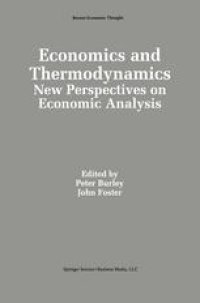
Ebook: Economics and Thermodynamics: New Perspectives on Economic Analysis
- Tags: Methodology and the History of Economic Thought, Economic Theory, Physical Chemistry
- Series: Recent Economic Thought Series 38
- Year: 1994
- Publisher: Springer Netherlands
- Edition: 1
- Language: English
- pdf
Over the past two decades we have witnessed something of a revolution in the natural sciences as thermodynamic thinking evolved from an equilibrium, or 'classical', perspective, to a nonequilibrium, or 'self organisational' one. In this transition, thermodynamics has been applied in new ways and in new fields of inquiry. Chemical and biological (evolutionary) processes have been analysed, increasingly, in non equilibrium thermodynamical terms. Economics has, since the late 19th century, relied heavily upon metaphors and analogies derived from the natural sciences - mechanical analogies cast in terms of traditional Newtonian physics and expressed in terms of Cartesian logic have been especially popular. Thermodynamics, on the other hand, has been less popular, despite its early application in economics by Stanley Jevons, the father of modern notions of utility maximisation in neoclassical economics, and despite its promotion in economic contexts by Paul Samuelson, the author of the definitive treatise upon which post war neoclassical economic theory was based, namely, his Foundations of Economic Analysis. The general neglect of thermodynamic thinking in economics was brought to our attention by Nicholas Georgescu-Roegen in the late 1960s, by which time economic theory, evidenced in, for example, the Arrow Debreu general eqUilibrium system, had become so sophisticated that it could not be penetrated by thermodynamical ideas. To Georgescu Roegen, this presented something of a crisis in economics because neglect of thermodynamics led, in his view, to blindness amongst economists to an economy/environment problem in the global economy.
This book offers insights into recent research focusing on the interface between thermodynamics and economics. Although nonequilibrium thermodynamics and self-organisation appear to offer more exciting possibilities for economic application, the early papers in the volume demonstrate that economic insights are still derivable from the standpoint of classical thermodynamics. In particular, the analytical framework set out decades ago by John von Neumann is shown to be a particularly rich source of insights and new perspectives.
The book attempts both to promote and critically evaluate the application of nonequilibrium thermodynamics of economics. The latter part of the book stresses that there are aspects of socioeconomic systems which we cannot understand using only the thermodynamic analogy, although thermodynamic metaphors can still offer us inspiration in formulating unique characterisations of economic complexity and organisation. The emerging fields of artificial life simulation and the mathematics of nonlinear dynamics also have a role to play in the paradigmatic shift which is now found in economics. Furthermore, it has to be acknowledged that a great deal of economic wisdom currently contained in orthodox economic thought will be of continued relevance and, indeed, may constitute much of the distinctiveness of self-organisational processes in the domain of economic analysis.